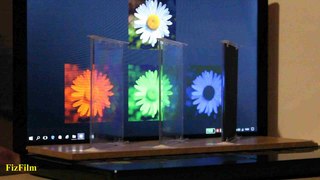Related Research Articles

A plotter is a machine that produces vector graphics drawings. Plotters draw lines on paper using a pen, or in some applications, use a knife to cut a material like vinyl or leather. In the latter case, they are sometimes known as a cutting plotter.

The RGB color model is an additive color model in which the red, green, and blue primary colors of light are added together in various ways to reproduce a broad array of colors. The name of the model comes from the initials of the three additive primary colors, red, green, and blue.

gnuplot is a command-line and GUI program that can generate two- and three-dimensional plots of functions, data, and data fits. The program runs on all major computers and operating systems . It is a program with a fairly long history, dating back to 1986. Despite its name, this software is not part of the GNU Project.
Gamma correction or gamma is a nonlinear operation used to encode and decode luminance or tristimulus values in video or still image systems. Gamma correction is, in the simplest cases, defined by the following power-law expression:
The Windows API, informally WinAPI, is Microsoft's core set of application programming interfaces (APIs) available in the Microsoft Windows operating systems. The name Windows API collectively refers to several different platform implementations that are often referred to by their own names ; see the versions section. Almost all Windows programs interact with the Windows API. On the Windows NT line of operating systems, a small number use the Native API.
The BMP file format, also known as bitmap image file, device independent bitmap (DIB) file format and bitmap, is a raster graphics image file format used to store bitmap digital images, independently of the display device, especially on Microsoft Windows and OS/2 operating systems.
In computing, WinG is an application programming interface that was designed to provide faster graphics performance on Windows 3.x operating environments, and was initially positioned as a way to help game developers more easily port their DOS games to Microsoft Windows, although it was quickly discontinued in favor of DirectX.
Color depth or colour depth, also known as bit depth, is either the number of bits used to indicate the color of a single pixel, or the number of bits used for each color component of a single pixel. When referring to a pixel, the concept can be defined as bits per pixel (bpp). When referring to a color component, the concept can be defined as bits per component, bits per channel, bits per color, and also bits per pixel component, bits per color channel or bits per sample (bps). Modern standards tend to use bits per component, but historical lower-depth systems used bits per pixel more often.

The Color Graphics Adapter (CGA), originally also called the Color/Graphics Adapter or IBM Color/Graphics Monitor Adapter, introduced in 1981, was IBM's first color graphics card for the IBM PC and established a de facto computer display standard.
IDL, short for Interactive Data Language, is a programming language used for data analysis. It is popular in particular areas of science, such as astronomy, atmospheric physics and medical imaging. IDL shares a common syntax with PV-Wave and originated from the same codebase, though the languages have subsequently diverged in detail. There are also free or costless implementations, such as GNU Data Language (GDL) and Fawlty Language (FL).

The IBM 1130 Computing System, introduced in 1965, was IBM's least expensive computer at that time. A binary 16-bit machine, it was marketed to price-sensitive, computing-intensive technical markets, like education and engineering, succeeding the decimal IBM 1620 in that market segment. Typical installations included a 1 megabyte disk drive that stored the operating system, compilers and object programs, with program source generated and maintained on punched cards. Fortran was the most common programming language used, but several others, including APL, were available.

Cairo is an open-source graphics library that provides a vector graphics-based, device-independent API for software developers. It provides primitives for two-dimensional drawing across a number of different back ends. Cairo uses hardware acceleration when available.
FOCAL is an interactive interpreted programming language based on JOHNNIAC Open Shop System (JOSS) and mostly used on Digital Equipment Corporation (DEC) Programmed Data Processor (PDP) series machines.

The Parallax P8X32A Propeller is a multi-core processor parallel computer architecture microcontroller chip with eight 32-bit reduced instruction set computer (RISC) central processing unit (CPU) cores. Introduced in 2006, it is designed and sold by Parallax, Inc.
In computing, a bitmap is a mapping from some domain to bits. It is also called a bit array or bitmap index.

PLplot is a library of subroutines that are often used to make scientific plots in compiled languages such as C, C++, D, Fortran, Ada, OCaml and Java. The library also exists as an unofficial binding for the .NET runtime. PLplot can also be used interactively by interpreted languages such as Octave, Python, Perl and Tcl. The current version was written primarily by Maurice J. LeBrun and Geoffrey Furnish.
The Apple II graphics were composed of idiosyncratic modes and settings that could be exploited. This graphics system debuted on the original Apple II, continued with the Apple II Plus and was carried forward and expanded with the Apple IIe, Enhanced IIe, IIc, IIc Plus and IIGS.
Absoft Fortran Compilers are set of Fortran compilers for Microsoft Windows, Apple Macintosh, and Linux produced by Absoft Corporation. The compilers are source code compatible across platforms.
References
- 1 2 "PGPLOT Graphics Subroutine Library". sites.astro.caltech.edu. Retrieved 2022-08-24.
- ↑ "PG2PLplot: transition from PGPlot to PLplot, by AstroFloyd". pg2plplot.sourceforge.net. Retrieved 2022-08-24.